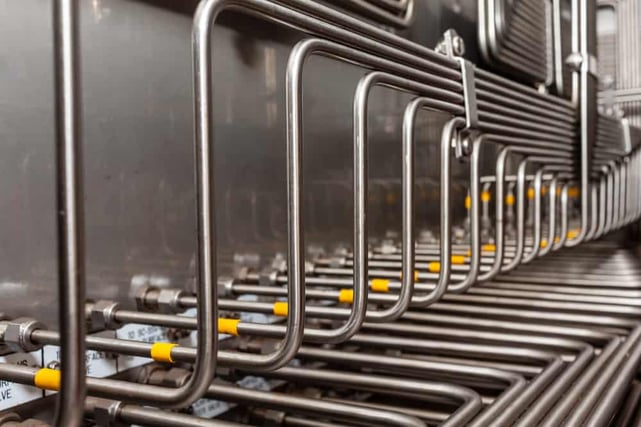Share this
High Pressure Stainless Steel Tubing’s Role in Instrumentation in the Petrochemical Industry
by Jason Burns on 10/25/22 9:00 AM

Most petrochemical processes are operated under high pressure and high temperatures for an extended period of time. This includes a variety of applications from transporting hydrocarbon fluids to processing petroleum products. Accidental leaks and bursts are major concerns in these processes which can stem from the use of material and components unsuitable for these conditions. For the safety and reliability of operations in your Northern California petrochemical facility, Swagelok’s high-pressure stainless steel tubings provide a high-strength, leak-free solution.
The Need for High-Pressure Stainless Steel Tubing
While manufacturing standards for each petrochemical product may differ, many of them involve chemical processing under elevated conditions. These can be risky pressure conditions to work with as the chances of leaks and failures rise exponentially when:
- The components are improperly installed
- The components used do not meet the required specifications
- There are many potential leak points, i.e., connection points and fittings
When the piping system in a facility is connected with multiple fittings—or when one component does not meet the proper standard—leaks are highly likely to occur.
An added issue in this highly pressurized system is the nature of the chemical being processed. While most organic chemicals may be less corrosive, petrochemical processing involves acidic and basic minerals. When pipes of carbon steel are exposed to these harsh chemicals, the corrosion of metal can create further damage to the manufacturing system.
High-pressure stainless steel tubing is the solution to these issues faced in petrochemical production. Depending on the requirement, these types of tubing may be used for up to 60,000 psig. The use of stainless steel provides resistance against corrosion. Moreover, the high-pressure tubing is far more robust compared to the piping systems. Here are further benefits that these tubing systems provide:
- Tubing does not require as many connections as the pipes, reducing the number of potential leaking points.
- Tubes can be bent to navigate around the corners without the need to install any fittings.
- Leak-free sealing is possible when tubes are connected with specialized high-pressure fittings.
Orbital Welding: Easy Fabrication of High-Pressure Tubing
When further reliability is required from a high-pressure petrochemical tubing system, it is better to use welded tubes. However, welding tubing is not an easy task. Most tubings are of smaller diameter and are thin-walled, so a single misjudgment of weld parameter can damage the entire tubing system.
Care should be taken so as to not lose the strength and integrity of the tubing to withstand extreme process conditions. Thin-walled tubings can burn through easily or distort when there is a slight fluctuation of heat input. Stainless steel further escalates this issue as its low thermal conductivity minimizes the heat distribution throughout the metal causing the tubings to warp or bend. Furthermore, there are challenges to operator safety as stainless steel welding is the source of hazardous hexavalent chromium which is detrimental to human health.
Orbital welding can make it easier to overcome the challenges of welding high-pressure stainless steel tubing. Orbital welding (also known as gas tungsten arc welding, or GTAW) means:
- It protects the weld from contamination through shielding
- Continuous welding facilitated by automation prevents uneven heating, minimizing issues like warping or distortion
- The use of different weld heads and monitoring system help protect operators from hazards
- The continuous and controlled process help reduce tubing welding completion time and lead to better quality
Swagelok High-Quality Solutions for Petrochemical Processing
Swagelok provides a range of high-pressure stainless steel tubing as well as orbital welding systems that you can use in your petrochemical facility. Our tubing systems are fabricated following ASME Code for Process Piping, B31.3 and are suitable for very high-pressure fluid handling (up to 60,000 psig). The 316/316L stainless steel provides high resistance to corrosion and is also suitable to use at high temperatures.
Orbital welding systems such as Swagelok’s M200 Orbital Welding System can perform ASME BPVC Section IX quality welds. When used with high-performance weld heads, the results are consistent and reliable welds that are cost-effective for your petrochemical facility.
With quality high-pressure stainless steel tubing and orbital welding systems from Swagelok, you can meet the demanding requirements of the petrochemical industry, making the manufacturing process safe and reliable—leak-free, corrosion-resistant, and capable of withstanding high pressure and temperature.
To find out more about how Swagelok Northern California can help your petrochemical industry meet all requirements with its range of high-pressure stainless steel tubing and high-quality solutions, contact our team today by calling 510-933-6200.
 About Morgan Zealear | Product Engineer, Assembly Services
About Morgan Zealear | Product Engineer, Assembly Services
Morgan holds a Bachelor of Science in mechanical engineering from University of California at Santa Barbara. He is certified in Section IX, Grab Sample Panel Configuration and Mechanical Efficiency Program Specification (API 682), and he is well versed in B31.3 Process Piping Code. Before joining Swagelok Northern, he was a manufacturing engineer at Sierra Instruments, primarily focused on capillary thermal meters for the semiconductor industry (ASML).
Share this
- Archive (465)
- Assembly Services (207)
- About (100)
- Seal Support Systems (96)
- Best Practices (88)
- Training Services (74)
- Fittings (51)
- Semiconductor Applications (49)
- Hoses and Flexible Tubing (47)
- Regulators (44)
- Tubing (42)
- Grab Sampling Systems (32)
- Sampling Systems (32)
- Gas Systems (30)
- Services (30)
- Downloads (29)
- Valves (24)
- Application Support (18)
- Orbital Welding (17)
- Case Studies (13)
- Steam Systems (13)
- Frequently Asked Questions (12)
- Tools (12)
- Measurement Devices (7)
- Subsystems (6)
- Thermal Management (6)
- September 2023 (1)
- August 2023 (2)
- June 2023 (1)
- March 2023 (3)
- February 2023 (3)
- January 2023 (4)
- December 2022 (4)
- November 2022 (4)
- October 2022 (4)
- September 2022 (1)
- August 2022 (3)
- July 2022 (2)
- June 2022 (4)
- May 2022 (1)
- April 2022 (2)
- March 2022 (1)
- February 2022 (2)
- January 2022 (3)
- December 2021 (1)
- November 2021 (6)
- October 2021 (6)
- September 2021 (8)
- August 2021 (4)
- July 2021 (3)
- June 2021 (6)
- May 2021 (6)
- April 2021 (7)
- March 2021 (5)
- February 2021 (4)
- January 2021 (6)
- December 2020 (5)
- November 2020 (6)
- October 2020 (6)
- September 2020 (8)
- August 2020 (7)
- July 2020 (8)
- June 2020 (8)
- May 2020 (6)
- April 2020 (9)
- March 2020 (7)
- February 2020 (10)
- January 2020 (21)
- December 2019 (23)
- November 2019 (21)
- October 2019 (22)
- September 2019 (21)
- August 2019 (22)
- July 2019 (23)
- June 2019 (20)
- May 2019 (23)
- April 2019 (22)
- March 2019 (21)
- February 2019 (20)
- January 2019 (21)
- December 2018 (14)
- November 2018 (19)
- October 2018 (23)
- September 2018 (17)
- August 2018 (29)
- July 2018 (11)
- June 2018 (6)
- May 2018 (5)
- April 2018 (4)
- March 2018 (5)
- February 2018 (3)
- January 2018 (3)
- December 2017 (2)
- November 2017 (4)
- October 2017 (3)
- September 2017 (2)
- August 2017 (6)
- July 2017 (4)
- June 2017 (4)
- May 2017 (4)
- April 2017 (3)
- March 2017 (4)
- February 2017 (3)
- January 2017 (3)
- December 2016 (3)
- November 2016 (3)
- October 2016 (3)
- September 2016 (5)
- August 2016 (5)
- July 2016 (4)
- June 2016 (5)
- May 2016 (3)
- April 2016 (4)
- March 2016 (5)
- February 2016 (11)
- January 2016 (1)
- December 2015 (3)
- November 2015 (4)
- October 2015 (3)
- September 2015 (4)
- August 2015 (4)
- July 2015 (8)
- June 2015 (5)
- May 2015 (3)
- April 2015 (4)
- March 2015 (4)
- February 2015 (3)
- January 2015 (4)
- December 2014 (2)
- November 2014 (3)
- October 2014 (4)
- September 2014 (4)
- August 2014 (4)
- July 2014 (5)
- June 2014 (4)
- May 2014 (4)
- April 2014 (5)
- March 2014 (4)
- February 2014 (3)
- January 2014 (4)
- December 2013 (5)
- November 2013 (3)
- October 2013 (4)
- September 2013 (3)
- August 2013 (5)
- July 2013 (5)
- June 2013 (5)
- May 2013 (3)
- April 2013 (6)
- March 2013 (4)
- February 2013 (4)
- January 2013 (8)
- December 2012 (4)
- November 2012 (6)
- October 2012 (6)
- September 2012 (4)
- August 2012 (4)
- July 2012 (4)
- June 2012 (4)

.webp?width=210&height=70&name=StickyLogo%20(5).webp)